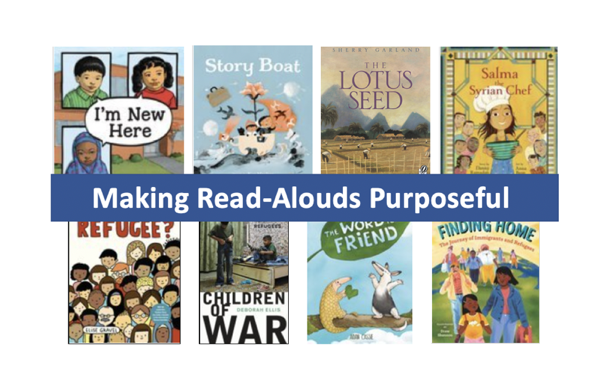
By Deborah McCallum
Read-alouds are potent vehicles for teaching listening and reading comprehension to any age group. Often very enjoyable experiences for primary students, they can be very entertaining and educational. Educators provide read-alouds for various reasons that range from entertaining students, providing exposure to vocabulary, introducing new ideas, creating opportunities to hear how words sound, building background knowledge, accessing simple and complex comprehension strategies, to discussing key concepts and themes interactively. Often, we choose read-alouds merely for entertainment, to fill an empty spot, to break up a lesson, teach something simple of value. As a result, a typical pattern has emerged where Read Alouds follow a predictable ‘Initiate, Respond, Evaluate’ structure. This is especially common if we don’t prioritize enough time to plan for a high quality read aloud. The ability to develop and design read-aloud lesson plans is a very complex process. Well-prepared, purposeful Read-alouds are connected to the curriculum, and educators know why they are reading that particular book at that particular time. Thus, purposeful planning will have a profound influence on student achievement. There is strong evidence that reading aloud fosters print awareness, phonemic awareness and oral language skills, comprehension skills, knowledge of genre, differences between fiction and non-fiction, structure of story, knowledge of text features, and identifying author’s purpose. Instructional planning that includes ‘think alouds’, and stopping at strategic points to model what good readers think about, engaging students in metacognitive thinking, educators are able to target not just the curriculum, but also activate the brain pathways that readers use to make meaning of text. Therefore, purposeful planning is essential. What are some of the ways to facilitate rich read-aloud discussions? The rest of this article will explore different strategies to provide a strong read-aloud.The purpose of this article is to share great ways to make Read-Alouds purposeful.
Picture Books
Educators often center read-alouds around picture books with visual and written text. This is a powerful way to engage all readers, especially our primary students. However, educators often privilege written text over visual text. It is important to also remember to purposefully plan for the visual texts in a picture book as well, because they often convey a narrative’s most critical facets. Therefore, It is essential to learn about and plan for a discussion of artistic elements and principles of design when using read-aloud picture books. A great strategy when using picture books, is to purposefully pair complex storybooks with one or more non-fiction or informational texts. This provides deeper and more significant learning opportunities for students including the opportunity to learn about and reinforce more complex vocabulary, build content knowledge and highlight other important real-world concepts.
Non-Fiction Read-Alouds
Often, there is a fear that Non-Fiction texts are too tricky for younger students to understand; we think they are not engaging and will not hold attention. Non-Fiction texts are also referred to as informational texts and go beyond books to include news articles, websites, and even social media. It also takes more planning to keep students engaged in conversations about informational texts. Educators will need to do a lot more pre-planning, including the paraphrasing of individual sections, conducting additional research into the content, understanding the curriculum, and triangulating previous assessments about students and their abilities to understand non-fiction content in subjects like science.
What we do know is that our young students do in fact show genuine interest in informational texts. We also know that they are very capable of understanding the features and structures of non-fiction texts. We also know that informational texts play critical roles in developing content knowledge, vocabulary knowledge, text structures, and features. What is most important is how we use non-fiction read-alouds to both build knowledge and activate background knowledge.
Building Background Knowledge & Equity
Background knowledge and how we activate and build it through read-alouds, is an equity issue. We can either promote inequities in learning opportunities, or we can purposefully plan our read-alouds in ways that honour the learners. It is always essential to ask ourselves with our planning, who will be left behind by the strategies that expect common knowledges and understandings. We also need to attend to our ideas about how and when background knowledge should be developed? How we plan to build background knowledge is an equity issue. It is important to build new content knowledge purposefully, and integrated within other content-based activities before introducing new learning in a read-aloud. If we pay less attention to the acquisition of content and background knowledge and focus solely on comprehension strategies like predicting, summarizing, and connecting, we drastically limit the learning potential of students. Sometimes background knowledge is activated before reading, but more often, the pre-reading task becomes a time to share new knowledge and ideas, and this can be problematic in a purposeful read aloud. First, this act of creating new knowledge right before a read-aloud can cause vastly uneven differences in how content is understood, and therefore inadvertently diminish comprehension. Next, when new information is shared right before a read-aloud, it may not solely be that students might fail to learn it in time, but rather that they will not be able to use it effectively within complex activities, like interactive read-alouds with complex texts and clear purposes. Finally, of crucial significance, is that students from diverse cultural and socioeconomic backgrounds and multilingual students may experience varying degrees of ability to engage with and learn the new knowledge added before a read aloud. Intentionally ensuring that we are activating background knowledge, versus building new knowledge in a read aloud is essential to creating equitable learning opportunities.
It is also essential to consider building the right kind of knowledge to support reading comprehension. Kaefer (2020) shares that incorrect background knowledge can inhibit understanding or negatively affect student learning. For example, when reading Charlotte’s Web, the process of activating background knowledge of a farm will be unlikely to help comprehend the critical themes of loyalty and friendship. Can you think about how activating certain types of knowledge can diminish students’ ability to understand the story? It is crucial to think about because activating background knowledge is different than providing the most relevant background knowledge before a Read-aloud. If we provide only the most pertinent background knowledge before reading, students may not learn it in time. The new information may not be robust enough to be easily accessible when engaging with complex comprehension processes. The success of pre-reading as a process to scaffold learning is dependent on the background knowledge that students already have.
New information in pre-reading can be an excellent starter for simple comprehension however, and merely supporting learning about a topic. Therefore, next time, in a pre-read, ensure that not all information and knowledge provided is new. It will also be essential to revisit the new knowledge provided. The following will describe a framework that explains how to deliver a Read-aloud, where a pre-reading strategy is not an effective way to transmit knowledge.
R.E.A.L.: Read, Explore, Ask and Learn
R.E.A.L. is a strategy created by E.Bingham et al., (2017). It is an authentic framework designed to integrate and connect informational texts with narrative texts to build content knowledge and vocabulary knowledge in authentic and engaging ways. It takes detailed planning. This planning starts with intentionally choosing a complex picture book. Next, consider the following variables that include, but are not limited to, the characters and depth of personality traits, the ability to infer a central idea or problem, make cross-connections between texts and to activate background knowledge, access to unfamiliar vocabulary, and rich illustrations that may not match the written text. A sophisticated story will also invite educators to design think-alouds around complex words and opportunities to discuss how the illustrations and written texts work together to make meaning.
Check out the following examples of paired texts and possible curriculum connections:
| Possible Curriculum Connections | Complex Story Examples | Non-Fiction Text Pairing | Multimedia Pairing |
| Residential Schools Truth & Reconciliation | When We Were Alone, by David A. Robertson | Phyllis’s Orange Shirt, Ages 3-5 The Orange Shirt Story, Grades 2-5 What is Orange Shirt Day?, CBC Kids | Orange Shirt Day, CBC Kids News |

| Possible Curriculum Connections | Complex Story Examples | Non-Fiction Text Pairing | Multimedia Pairing |
| Structures Homes Community & Culture | If I Built a House, by Chris Van Dusen What We Do in Our Community, by Ali Hinch | Take Shelter: At Home and Around the World, by Nikki Tate & Dani Tate-Stratton The Homes We Build, Lawrence King Publishing | 7 Unbelievable Bridges from Around the World, CBC Kids |

| Possible Curriculum Connections | Complex Story Examples | Non-Fiction Text Pairing | Multimedia Pairing |
| Immigration Refugees Culture People | I’m New Here, by Anne Sibley O’Brien Story Boat, by Kyo Maclear The Lotus Seed, by Sherry Garland & Tatsuro Kiuchi Salma, the Syrian Chef, by Anna Bron | What is a Refugee?, by Elise Gravel Children of War: Voices of Iraqi Refugees, by Deborah Ellis, Ages 12 & under The Word for Friend, by Aiden Cassie, Ages 4-8 Finding Home: The Journey of Immigrants and Refugees, by Jen Sookfong (Release date March 2021) |
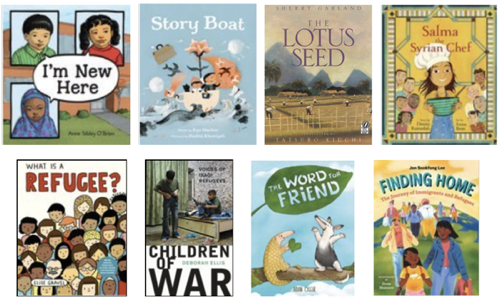
| Possible Curriculum Connections | Complex Story Examples | Non-Fiction Text Pairing | Multimedia Pairing |
| Environment Energy | The Boy Who Harnessed the Wind, by William Kamkwamba Brian Mealer, & Elizabeth Zunon | Brilliant! Shining a Light on Sustainable Energy, by Michelle Mulder | 5 Inventions That Changed the World, CBC Kids |

| Possible Curriculum Connections | Complex Story Examples | Non-Fiction Text Pairing | Multimedia Pairing |
| Mental Health Self-Regulation | Anh’s Anger, by Gail Silver & Christiane Kromer Take a Deep Breath, by Sue Graves & Desideria Guicciardini | What Does It Mean to Be Present?, by Rana DiOrio | What Causes Anxiety and Depression?, based on Inside Out |
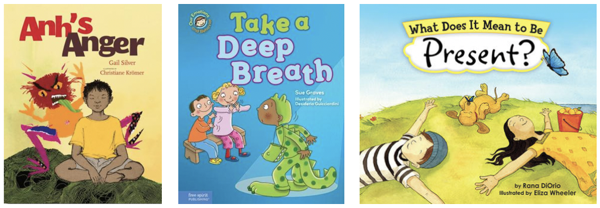
| Possible Curriculum Connections | Complex Story Examples | Non-Fiction Text Pairing | Multimedia Pairing |
| Leaves Winter Snow Seasons | Last Leaf First Snowflake to Fall, by Leo Yerxa | Why do leaves change colour?, by Betsy Maestro The Story of Snow, by Mark Cassino | Getting Up Close with Snowflakes, CBC Kids The Snowy Day – Read aloud picture book, TED-ED |

| Possible Curriculum Connections | Complex Story Examples | Non-Fiction Text Pairing | Multimedia Pairing |
| Environment Helping the Planet | The Little Hummingbird, by Michael Nicoll Yahgulanaas | A Child’s Introduction to the Environment: The Air, Earth, and Sea Around Us- Plus Experiments, Projects, and Activities YOU Can Do to Help Our Planet!, by Dennis Driscoll, Michael Driscoll & Meredith Hamilton | 3 Reasons to be Kinder to the Earth, CBC Kids |
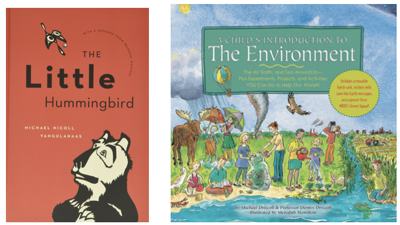
| Possible Curriculum Connections | Complex Story Examples | Non-Fiction Text Pairing | Multimedia Pairing |
| Food Growth & Development | Carrot Seed, by R. Krouss The Children’s Garden: Growing Food in the City, by Pierr Morgan Because of an Acorn, by Lola M. Schaefer & Adam Schaefer | How a Seed Grows, by H. Jordan Growing Food for Beginners, by Abigail Wheatley Acorn to Oak Tree, by Camilla de la Bedoyere | The Future of Food, TED-ED 3 Sisters and Other Indigenous Foods, CBC Kids How much do you really know about fruit?, CBC Kids |
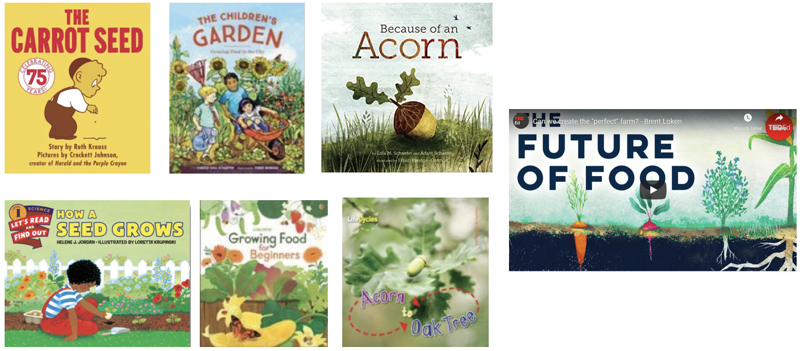
Read and Explore
First, start with a storybook read aloud. While reading, explore concepts not already understood, and purposefully explore a question. Next, address this question through a Non-Fiction text. Let students know that we do not read information texts from cover to cover like a story. Look at the text features like illustrations, photos, captions, charts, maps, and more. Model use of text features like the table of contents—direct attention to bold words and definitions in the glossary. Model a think-aloud strategy to show what a strong reader does when they use the information. Next, consider what students already know and decide how you will expand on that knowledge. Finally, decide on the most critical and intentional questions that will help students synthesize information. Consider creating a ‘Question and Answer’ chart to keep track of the thinking.
Ask and Learn
The next parts of REAL are about planning for Ask and Learn. Here is where the process begins to link previously learned information with new content knowledge. As students start to think about reading informational texts, they can also learn about text features and decide how they will read and find answers. Next, it is vital to help students ‘Ask’ by formulating and using guiding questions to examine essential vocabulary and concepts. Finally, in Learn, the planning is also purposeful. Plan for students to extend purposeful activities in other content areas and through play. Create intentional learning times and spaces for content areas like science. Actively plan to incorporate new vocabulary in science experiments, nature walks, writing activities, and more.
Interactive Read-Alouds
A key feature of an interactive read-aloud is the conversations about text throughout the reading vs. waiting until finished to have a discussion. An interactive read-aloud is in contrast to a think-aloud. We can create goals for interactive read-alouds that will expose students to various texts, model fluent reading, and co-create meaning with students by encouraging discussion to deepen and build understanding, enhance thinking, and provide clarity to the students about the reading behaviours we want them to use independently. We can think of an interactive read-aloud lesson plan with a structure of pre-reading, during reading, and post-reading sections.
Choosing Your Read-Alouds
When deciding on the texts that you will read aloud with your students, it is very important to consider your collection and ask whose voices are being represented? Whose stories are being told? Are my students able to see themselves reflected in the texts? Planning out your read-alouds with your long-range plans is a great way to ensure that the texts that you are infusing help to share new and diverse ways of thinking about the world, and that can serve as both mirrors, windows and sliding doors for our students. To learn more please watch this video of Randine Lewis explaining Mirrors, Windows and Sliding Doors. Pairing fiction and non-fiction texts is a powerful way to ensure diversity in our books.
Pre-Reading
Pre-reading, in an interactive read-aloud of a complex storybook, is meant to get students to think about what they already know about non-fiction or the non-fiction topic. Pre-reading strategies can change depending upon the curriculum-based goal(s) you have set for your read-aloud. Remember to activate background knowledge more than teaching new information. One idea is to have students make predictions based on the cover and teach them how to effectively engage in activities including ‘turn and talk’ to share predictions and reinforce the importance of always returning to the book cover to locate evidence. This type of strategy ensures that all students have the opportunity to think, share, and interact, and the more exposure each student has to co-create meaning, the better readers they can become. In terms of your ongoing assessment, note the vocabulary students are using, turn text over and read the blurb, read the ‘about the author’ section, and share your prediction that you pre-wrote on a sticky note. Continue the activity by having students turn and talk again about whose predictions are better and why. Ask what you are already thinking about this book.
Commonly, when we plan a read-aloud, we focus on word solving, fluency, summarizing, finding the main idea, and predicting. However, also consider these additional curriculum areas when planning for a read-aloud:
- Analyzing underlying text structures, categories of information, causes and effects, problems, and solutions
- Synthesizing information and changing how we think in response to new information
- Making inferences; “reading between the lines,” making connections, and drawing conclusions
- Critiquing the text with our own opinions and supporting this with evidence from the story
- Making strong connections; explicitly helping students to describe the relationships between their connections
- Engaging in the ongoing school-wide work to help support read-alouds with curriculum connections to content, skills, and strategies
- Engaging in the ongoing discussions about previous assessments, the background knowledge of students
- Anticipating how students may respond and think about possible student misconceptions that may arise
- Developing strong questioning skills; inviting students to ask their own questions about illustrations, information, story characters etc.
- Sparking curiosity; using read-alouds to provoke interest and wonder.
- Provoking thoughtful reflection on topics such as self-regulation, bullying, abuse, death, racial issues, pollution, ecoliteracy and more
These discussions are essential for proper scaffolding and support of student reading. Also, consider keeping a visible classroom or library, virtual or physical reading log of read-alouds to help students make text-to-text connections explicitly:
Classroom Reading Log
| Author | Title | Genre | Topic & (F / NF) | Critical information, skills, strategies |
After Reading
The consolidation of learning after a meaningful interactive read-aloud is essential. What we want to know is, what did students learn? How do I know they learned? If you support a learning goal (and all goals should be explicit for each read-aloud), students need to consolidate their learning. The consolidation will also provide you with valuable information to assess how they understood the story and the learning goal. Strategies including graphic organizers, letters, journal entries, poems, stories, opinions, story maps, timelines, plotlines, Venn diagrams, character sketches, both written and artistic, are all ways to support this consolidation.
Conclusion
Read alouds provide great opportunities for teacher-librarians and educators to support children’s vocabulary development, comprehension skills, and to build background knowledge. Strategies like R.E.A.L. also help children to share ideas, ask questions and build background knowledge. Important pedagogical strategies like purposeful before, during and after reading activities are very important to support student learning. Remember to make your Read-Alouds purposeful for the curriculum and student needs,strive to pair fiction and non-fiction books, learn comprehension skills and build vocabulary and concepts. Read-Alouds have so much power when used purposefully, and educators have the power to harness all of the tools, resources and knowledge at our disposal to create the kinds of meaningful experiences that Read-Alouds can provide.
References
Baker, Scott K., et al. “An Evaluation of an Explicit Read Aloud Intervention Taught in
Whole-Classroom Formats In First Grade.” The Elementary School Journal, vol. 113, no. 3, 2013, pp. 331–358. JSTOR, www.jstor.org/stable/10.1086/668503.
Burke, A. (2017). An Analysis of a Teacher’s Use of Revoicing During a Third Grade Literature Discussion. Literacy Research and Instruction, 56(1), 1–20. https://doi.org/10.1080/19388071.2016.1210707
E. Bingham, G., Venuto, N., Carey, M. et al. Making it REAL: Using Informational Picture Books in Preschool Classrooms. Early Childhood Educ J 46, 467–475 (2018). https://doi-org.myaccess.library.utoronto.ca/10.1007/s10643-017-0881-7
Kaefer, T. (2020). When Did You Learn It? How Background Knowledge Impacts Attention and Comprehension in Read‐Aloud Activities. Reading Research Quarterly, 55(S1), S173– S183. https://doi-org.myaccess.library.utoronto.ca/10.1002/rrq.344
Kuhn, K.E., Rausch, C.M., McCarty, T.G. et al. Utilizing Nonfiction Texts to Enhance Reading Comprehension and Vocabulary in Primary Grades. Early Childhood Educ J 45, 285–296 (2017). https://doi-org.myaccess.library.utoronto.ca/10.1007/s10643-015-0763-9
Reading Rockets: Mirrors, Windows, Sliding Doors (2015).
https://www.youtube.com/watch?v=_AAu58SNSyc
Spear-Swerling, L., Zibulsky, J. Making time for literacy: teacher knowledge and time allocation in instructional planning. Read Writ 27, 1353–1378 (2014). https://doi-org.myaccess.library.utoronto.ca/10.1007/s11145-013-9491-y
Stortz, R., Martinez, M., Harmon, J., Cataldo, R., & Juarez, L. M. (2019). Helping preservice teachers realize the transformative potential of read alouds. 40(3), 238-255. doi:10.1080/10901027.2018.1561560
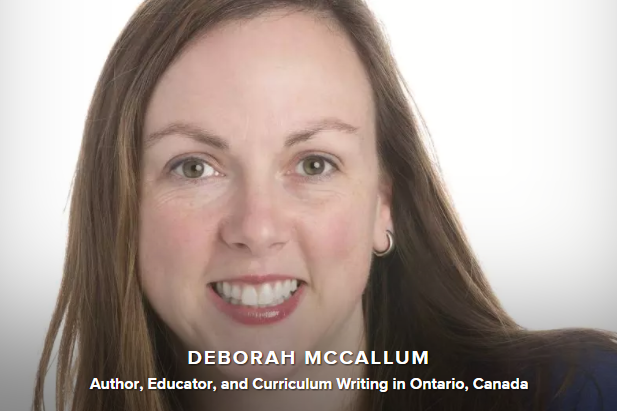
Deborah McCallum is an Instruction and Assessment Facilitator and former teacher-librarian for the Simcoe County District School Board in Ontario. Deborah is a highly-regarded blogger, sharing her ideas at Big Ideas in Education. Deborah is the author of the very successful book, The Feedback-Friendly Classroom: How to equip students to give, receive, and seek quality feedback that will support their social, academic and developmental needs (2015).